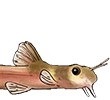Mazzoldi, C., V Lorenzi & MB Rasotto, 2007. Variation of male reproductive apparatus in relation to fertilization modalities in the catfish families Auchenipteridae and Callichthyidae (Teleostei: Siluriformes). Journal of Fish Biology 70: 243?256.
Abstract
To investigate the relationship between fertilization modalities and the morphology of male reproductive apparatus, two species of Auchenipteridae, Auchenipterus nuchalis and Tatia intermedia, and six species of Callichthyidae, Callichthys callichthys, Corydoras aeneus, Corydoras bondi, Corydoras ehrhardti, Corydoras potaroensis and Hoplosternum littorale were studied. The species analysed show either internal or external fertilization, the latter including the so called 'sperm drinking' type of mating. An anal fin modified as an intromittent organ, a pair of seminal vesicles, and the release of sperm in the form of discrete bundles (spermatozeugmata) characterize the male reproductive apparatus of the internal fertilizer A. nuchalis. Seminal vesicles are present also in C. aeneus, C. bondi, C. ehrhardti, C. potaroensis and H. littorale, species performing 'sperm drinking' spawning. In contrast, regardless of the family, species showing the more classic type of external fertilization lack specialized accessory organs. Where occurring, the major function of seminal vesicles is the secretion of mucins. The role of these mucosubstances, in relation to spermatozeugmata formation, in internal fertilizers, or the protection of sperm passing through the female gut, in the 'sperm-drinking' species, is discussed. Variation, between families, in the shape of testis and accessory structures, as well as in the type of spermatogenesis was found. Neither the reproductive modalities nor the phylogenetic relationships, however, appear to fully account for these differences.
Reproduction in Auchenipteridae and Callichthyidae
- Silurus
- Posts: 12420
- Joined: 31 Dec 2002, 11:35
- I've donated: $12.00!
- My articles: 55
- My images: 893
- My catfish: 1
- My cats species list: 90 (i:1, k:0)
- Spotted: 424
- Location 1: Singapore
- Location 2: Moderator Emeritus





